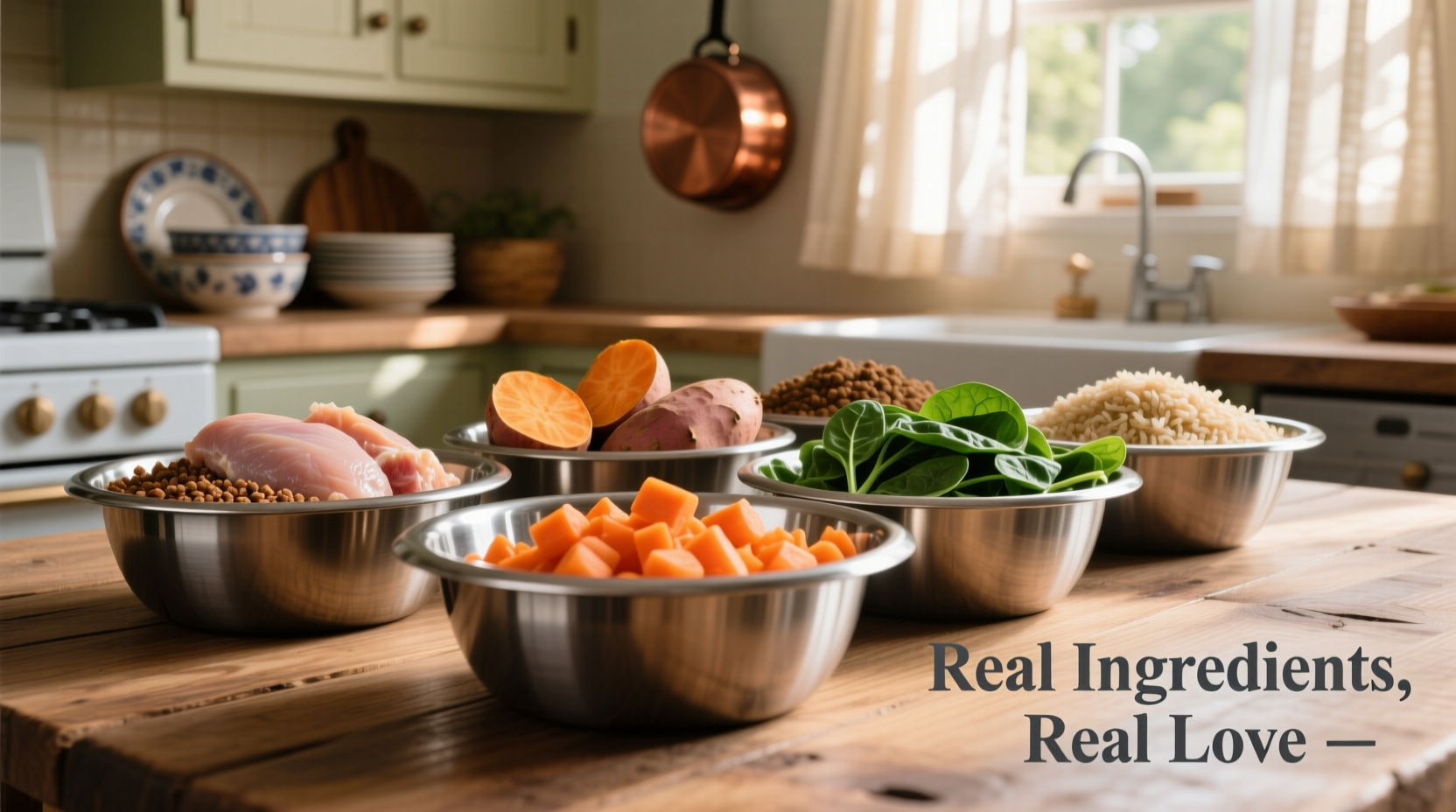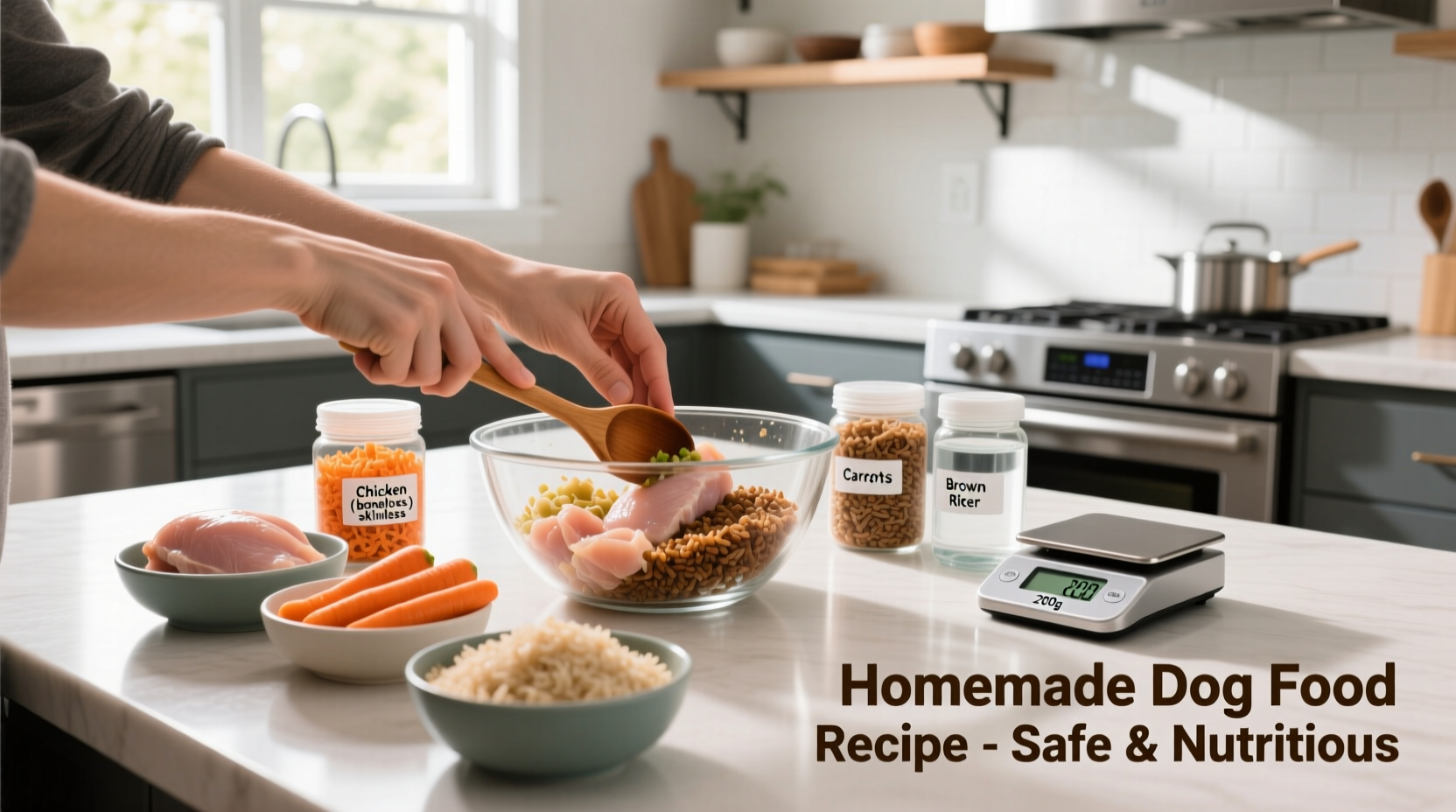Is Homemade Dog Food Right for Your Canine Companion?
Before you begin cooking, understand that homemade dog food isn't suitable for every pet. Veterinary nutritionists estimate only 15-20% of dog owners successfully create balanced homemade diets without professional guidance. Dogs have specific nutritional requirements that differ significantly from humans - they need precise calcium-to-phosphorus ratios, adequate taurine levels, and appropriate vitamin profiles that aren't intuitive to replicate.
Consider homemade food if your dog has:
- Documented food allergies to commercial ingredients
- Specific medical conditions requiring customized nutrition
- Consistent digestive issues with commercial options
Important: Never switch to homemade food for puppies, senior dogs, or pets with chronic health conditions without veterinary supervision. The American College of Veterinary Nutrition reports improper homemade diets cause more nutritional deficiencies than commercial foods.
Dog-Safe Ingredients vs. Dangerous Foods
| Safe Ingredients | Forbidden Ingredients | Use With Caution |
|---|---|---|
| Lean chicken, turkey, beef | Onions, garlic, chives | Eggs (limit to 1-2/week) |
| Cooked sweet potatoes | Grapes, raisins | Fish (due to mercury) |
| Carrots, green beans | Chocolate, caffeine | Dairy products |
| Brown rice, oats | Xylitol (in sugar-free products) | Fatty meats |
Based on FDA pet food safety guidelines and ASPCA toxicology data
Step-by-Step Preparation Process
Creating nutritionally complete homemade dog food requires precision. Follow this vet-approved workflow:
Phase 1: Recipe Development
Work with a board-certified veterinary nutritionist to formulate recipes meeting AAFCO nutrient profiles. The University of Tennessee College of Veterinary Medicine reports 95% of online dog food recipes lack essential nutrients. Essential components include:
- Protein source (25-30% of total recipe)
- Carbohydrate source (30-35%)
- Dog-safe vegetables (20-25%)
- Supplemental calcium (critical for bone health)
- Essential fatty acids (fish oil or flaxseed)
Phase 2: Cooking Protocol
- Prep ingredients: Use separate cutting boards for meat and vegetables. Wash all produce thoroughly.
- Cook proteins: Boil or bake lean meats until internal temperature reaches 165°F (74°C).
- Prepare carbohydrates: Cook brown rice or sweet potatoes until soft but not mushy.
- Steam vegetables: Lightly steam carrots and green beans to preserve nutrients.
- Mix components: Combine ingredients in precise ratios according to your vet's formula.
- Add supplements: Mix in calcium carbonate and fish oil after cooking.
Phase 3: Portioning and Storage
Divide into daily portions using a kitchen scale. Store in airtight containers:
- Refrigerator: Up to 3 days
- Freezer: Up to 3 months in portion-sized containers

Transitioning From Commercial to Homemade Food
Switching diets requires careful timing to avoid digestive upset. Follow this evidence-based transition timeline:
- Days 1-2: 25% homemade, 75% current food
- Days 3-4: 50% homemade, 50% current food
- Days 5-6: 75% homemade, 25% current food
- Day 7 onward: 100% homemade diet
Monitor your dog for these signs during transition:
- Normal stool consistency (should not be loose)
- Consistent energy levels
- Healthy coat and skin
- Appetite maintenance
If you notice vomiting, diarrhea, or lethargy, revert to previous ratio and consult your veterinarian. The Journal of Animal Physiology reports 30% of dogs experience digestive issues during improper diet transitions.
When Homemade Food Isn't Appropriate
Despite good intentions, homemade diets have significant limitations. Veterinary experts recommend against homemade food in these scenarios:
- Without professional formulation: 83% of homemade recipes analyzed by Cummings Veterinary Medical Center lacked essential nutrients
- For growing puppies: Developing dogs require precise calcium levels that are difficult to achieve at home
- For dogs with kidney disease: Requires exact phosphorus control only possible with therapeutic veterinary diets
- When cost is primary motivator: Properly balanced homemade food often costs more than premium commercial options
Consider commercial options if you lack time for proper formulation, preparation, and monitoring. Reputable brands undergo rigorous testing to meet AAFCO standards.
Monitoring Your Dog's Response
Track these key indicators to ensure your homemade diet succeeds:
- Weight management: Monthly weigh-ins should show stable weight
- Coat quality: Shininess and reduced shedding indicate proper fatty acid intake
- Digestive health: Firm, well-formed stools without excessive gas
- Energy levels: Consistent activity appropriate for breed and age
Schedule veterinary checkups every 6 months when feeding homemade diets. Blood tests can detect early nutritional deficiencies before visible symptoms appear.
Frequently Asked Questions
Can I make dog food without supplements?
No, complete supplementation is essential. Research from the University of Illinois shows 90% of homemade dog food recipes lack adequate calcium without supplementation. Dogs require precise vitamin and mineral balances that can't be achieved through whole foods alone. Always follow a veterinary nutritionist's supplement protocol.
How much homemade dog food should I feed my dog?
Portion size depends on your dog's weight, age, and activity level. As a general guideline, feed 2-3% of your dog's ideal body weight daily. For example, a 50-pound moderately active adult dog needs approximately 1-1.5 pounds of prepared food daily. Consult your veterinarian for precise calculations based on your recipe's caloric density.
Is raw dog food safer than cooked homemade food?
Raw diets carry significant risks. The FDA Center for Veterinary Medicine reports raw pet foods are 17 times more likely to contain harmful bacteria like Salmonella and Listeria. Cooking eliminates these pathogens while preserving most nutrients. If considering raw feeding, consult a veterinary nutritionist and follow strict food safety protocols.
How long does homemade dog food last in the refrigerator?
Properly stored homemade dog food remains safe for 3-4 days in the refrigerator at 40°F (4°C) or below. Always use airtight containers and cool food rapidly after cooking. For longer storage, freeze portions in labeled containers for up to 3 months. Thaw frozen portions in the refrigerator overnight - never at room temperature.
Can I use human vitamin supplements for my dog's food?
Absolutely not. Human supplements contain inappropriate dosages and potentially toxic ingredients for dogs. For example, many human multivitamins contain xylitol, which is lethal to dogs. Always use supplements specifically formulated for canine nutrition under veterinary guidance. The Merck Veterinary Manual details numerous cases of vitamin toxicity from improper supplementation.











 浙公网安备
33010002000092号
浙公网安备
33010002000092号 浙B2-20120091-4
浙B2-20120091-4